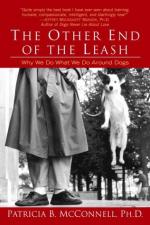
|
| Name: _________________________ | Period: ___________________ |
This test consists of 15 multiple choice questions and 5 short answer questions.
Multiple Choice Questions
1. What can a dog do if it gets fed up or angry with play fighting?
(a) The dog can run away.
(b) The dog can disobey.
(c) The dog can get hurt.
(d) The dog can lash out.
2. According to McConnell, what is the best word to use to encourage a dog's silence?
(a) Enough.
(b) Stop.
(c) Down.
(d) No.
3. What is the human equivalent of a "hip slam" and "shoulder slam"?
(a) "Back block."
(b) "Body block."
(c) "Leg block."
(d) "Arm block."
4. When a person cocks his or her head, what does it tell the dog?
(a) I am submissive toward you.
(b) I am dominant over you.
(c) I am a threat to you.
(d) I am no threat to you.
5. What myth do humans perpetuate about dog's regard for them, according to McConnell?
(a) That dogs give humans "unconditional negative regard."
(b) That dogs give humans "conditional positive regard."
(c) That dogs give humans "unconditional positive regard."
(d) That dogs give humans "conditional negative regard."
6. How many forms of play does McConnell recommend?
(a) Six.
(b) One.
(c) Endless.
(d) Three.
7. What are low pitched sounds used for?
(a) Positivity, authority, cheerfulness.
(b) Authority, encouragement, positivity.
(c) Authority, threat, disapproval.
(d) Disapproval, authority, positivity.
8. How many languages do the animal handlers McConnell researches use?
(a) 16.
(b) 37.
(c) 104.
(d) 202.
9. What are high pitched sounds NOT used for?
(a) Authority.
(b) Cheerfulness.
(c) Positivity.
(d) Encouragement.
10. What is the vomero-nasal organ on a dog?
(a) It is a structure that lets in smell molecules.
(b) It is a structure that closes off smell molecules.
(c) It is a structure that scent molecules stick to.
(d) It is a structure that smell molecules can't stick to.
11. According to McConnell, small _______impart big meaning for a dog.
(a) Movements.
(b) Looks.
(c) Treats.
(d) Words.
12. If an owner wants to encourage movement in a dog, what should she or he do?
(a) Use long, spare notes.
(b) Use short, repetitive notes.
(c) Use both long, repetitive notes.
(d) Use both short and spare notes.
13. McConnell suggests sniffing different parts of the house, plants, books, bedsheets, in order to determine what?
(a) If a dog has been there.
(b) If another person has been there.
(c) If they are clean.
(d) If there are distinct odors.
14. Studies prove that who can tell that a shirt has been worn by a man or woman?
(a) Primates.
(b) Dogs.
(c) Humans.
(d) Cats.
15. Why is it confusing for a dog when a person uses similar phrasing?
(a) Because these phrases sound aggressive to a dog.
(b) Because these phrases sound submissive to a dog.
(c) Because these phrases sound completely alike to a dog.
(d) Because these phrases sound completely different to a dog.
Short Answer Questions
1. According to McConnell, which breed is considered to be one of the greatest sniffers?
2. How many scent receptors do dogs have?
3. Why does commanding "down" for a dog to lie down and "down" for a dog to get off the couch confusing?
4. How can an owner make themselves the object of a chase?
5. According to McConnell, how can an owner effectively housebreak a dog?
|
This section contains 583 words (approx. 2 pages at 300 words per page) |

|




